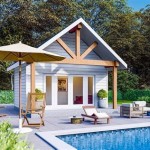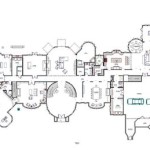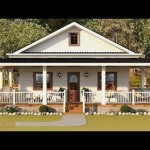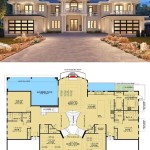Georgian House Floor Plans refer to the architectural layouts and designs of houses built during the Georgian era, which spanned from 1714 to 1830. Georgian architecture is characterized by its symmetry, proportion, and elegance, and its floor plans reflect these principles.
Georgian houses were typically built as rectangular structures, with a symmetrical front faade and a central door flanked by windows. The interior layout often featured a central hallway running through the house, with formal rooms on either side. The ground floor typically comprised a large entrance hall, a drawing room, a dining room, and a library or study. The upper floors housed bedrooms and dressing rooms.
The floor plans of Georgian houses were designed to create a sense of order and balance. The use of symmetry and proportion ensured that the rooms were visually pleasing and harmonious. The central hallway served as a central axis, connecting the different parts of the house and providing a sense of flow. The formal rooms were typically large and airy, with high ceilings and large windows, while the bedrooms and dressing rooms were more intimate and private.
Georgian house floor plans are characterized by their symmetry, proportion, and elegance. Here are 8 important points about Georgian house floor plans:
- Rectangular structure
- Symmetrical front facade
- Central hallway
- Formal rooms on either side of hallway
- Large entrance hall
- High ceilings and large windows
- Intimate and private bedrooms
- Sense of order and balance
Georgian house floor plans were designed to create a sense of harmony and grandeur. The use of symmetry and proportion ensured that the rooms were visually pleasing and the central hallway provided a sense of flow. The formal rooms were typically large and airy, while the bedrooms and dressing rooms were more intimate and private.
Rectangular structure
Georgian houses are typically built as rectangular structures. This shape provides a number of advantages, including:
- Symmetry: A rectangular structure allows for a symmetrical facade, which is a key characteristic of Georgian architecture. Symmetry is considered to be aesthetically pleasing and creates a sense of balance and order.
- Proportion: The rectangular shape also allows for good proportions. Georgian houses are typically two or three stories high, with a width that is about twice the height. This proportion creates a visually pleasing appearance.
- Efficiency: A rectangular structure is also efficient in terms of space planning. The rooms can be arranged in a logical and efficient way, with minimal wasted space. This makes Georgian houses very livable and comfortable.
- Versatility: The rectangular shape of Georgian houses makes them adaptable to a variety of different needs. They can be built on narrow or wide lots, and they can be expanded or remodeled relatively easily.
The rectangular structure of Georgian houses is one of the key factors that contributes to their timeless appeal. This shape provides a number of advantages, both in terms of aesthetics and functionality.
Symmetrical front facade
One of the most distinctive features of Georgian architecture is its symmetrical front facade. This means that the front of the house is divided into two equal halves, with a central door flanked by windows on either side. The symmetry creates a sense of balance and order, and it is a key element of the Georgian aesthetic.
The symmetrical front facade was also a practical consideration. It allowed for a more efficient use of space, as the rooms could be arranged in a logical and symmetrical way. This made Georgian houses very livable and comfortable.
The symmetry of the front facade was often extended to the interior of the house. The central hallway would typically run through the center of the house, with formal rooms on either side. This layout created a sense of flow and grandeur, and it was a common feature of Georgian houses.
The symmetrical front facade is one of the key characteristics of Georgian architecture. It is a distinctive and elegant feature that creates a sense of balance and order. The symmetry was also a practical consideration, as it allowed for a more efficient use of space.
In addition to the above, the symmetrical front facade of Georgian houses also served a social function. It was a way of displaying the wealth and status of the owner. A large, symmetrical house with a grand facade was a sign of success and prosperity.
Central hallway
The central hallway is a key feature of Georgian house floor plans. It is a wide, central passageway that runs through the center of the house, from the front door to the back of the house. The central hallway serves a number of important functions:
- Circulation: The central hallway provides a central axis for circulation within the house. It allows for easy access to all of the rooms on the ground floor, and it also provides a connection between the front and back of the house.
- Focal point: The central hallway is often the focal point of the house. It is typically the first space that visitors see when they enter the house, and it sets the tone for the rest of the house. The hallway is often decorated with fine furniture, artwork, and other decorative elements.
- Natural light: The central hallway often features large windows at both the front and back of the house. This allows for natural light to flood into the hallway, creating a bright and airy space.
- Sense of grandeur: The central hallway can create a sense of grandeur and spaciousness. The wide, open space of the hallway makes the house feel larger and more impressive.
The central hallway is an essential element of Georgian house floor plans. It serves a number of important functions, both practical and aesthetic. The central hallway is a key part of what makes Georgian houses so distinctive and appealing.
The central hallway was often used to display the family’s wealth and status. The hallway would be decorated with fine furniture, artwork, and other expensive items. The size of the hallway was also a sign of wealth, as it indicated that the family had enough space to spare for a large, open space.
The central hallway also served a social function. It was a place where guests could be received and entertained. The hallway would often be used for parties and other social gatherings. The central hallway was also a place where the family could gather to spend time together.
The central hallway is a key feature of Georgian house floor plans. It is a versatile space that can be used for a variety of purposes. The central hallway is an important part of what makes Georgian houses so distinctive and appealing.
Formal rooms on either side of hallway
Georgian house floor plans typically feature formal rooms on either side of the central hallway. These rooms are typically the most important rooms in the house, and they are used for entertaining guests and other formal occasions.
The formal rooms in a Georgian house are typically large and airy, with high ceilings and large windows. They are often decorated with fine furniture, artwork, and other expensive items. The size and grandeur of the formal rooms were a sign of the wealth and status of the family.
The most common formal rooms in a Georgian house are the drawing room, the dining room, and the library. The drawing room is the main reception room in the house, and it is used for entertaining guests. The dining room is used for formal dining, and it is often connected to the kitchen by a butler’s pantry.
The library is a room that is used for reading and studying. It is often lined with bookshelves, and it may also contain a desk and other furniture. The library is a private space, and it is often used by the owner of the house to conduct business or to relax.
The formal rooms in a Georgian house are an important part of the overall design of the house. They are used for entertaining guests and other formal occasions, and they reflect the wealth and status of the family.
The formal rooms in a Georgian house are typically arranged in a symmetrical way. This symmetry creates a sense of balance and order, and it is a key element of the Georgian aesthetic. The symmetry of the formal rooms also makes the house feel more spacious and grand.
The formal rooms in a Georgian house are often connected to each other by large doorways. These doorways allow for easy flow of guests from one room to another. The doorways may also be flanked by columns or other decorative elements, which add to the grandeur of the space.
The formal rooms in a Georgian house are an important part of the overall design of the house. They are used for entertaining guests and other formal occasions, and they reflect the wealth and status of the family. The formal rooms are typically large and airy, with high ceilings and large windows. They are often decorated with fine furniture, artwork, and other expensive items.
Large entrance hall
The entrance hall is the first space that visitors see when they enter a Georgian house. It is a large, open space that sets the tone for the rest of the house. The entrance hall is typically decorated with fine furniture, artwork, and other expensive items. The size and grandeur of the entrance hall were a sign of the wealth and status of the family.
The entrance hall served a number of important functions. It was a place where guests could be received and entertained. It was also a place where the family could gather to spend time together. The entrance hall was often used for parties and other social gatherings.
The entrance hall was typically located at the center of the house. It was often flanked by the drawing room and the dining room. The entrance hall was also connected to the central hallway, which provided access to the rest of the house.
The entrance hall was an important part of the Georgian house floor plan. It was a large, open space that served a number of important functions. The entrance hall was a sign of the wealth and status of the family, and it was a place where guests could be received and entertained.
The entrance hall was often used to display the family’s wealth and status. The hall would be decorated with fine furniture, artwork, and other expensive items. The size of the hall was also a sign of wealth, as it indicated that the family had enough space to spare for a large, open space.
The entrance hall also served a social function. It was a place where guests could be received and entertained. The hall would often be used for parties and other social gatherings. The entrance hall was also a place where the family could gather to spend time together.
The entrance hall is a key feature of Georgian house floor plans. It is a versatile space that can be used for a variety of purposes. The entrance hall is an important part of what makes Georgian houses so distinctive and appealing.
High ceilings and large windows
Georgian houses are known for their high ceilings and large windows. These features are not only aesthetically pleasing, but they also serve a number of practical purposes.
- Natural light: The large windows in Georgian houses allow for natural light to flood into the rooms. This creates a bright and airy space, which is both inviting and comfortable.
- Ventilation: The high ceilings and large windows also help to ventilate the house. This is important for both comfort and health. The fresh air helps to keep the house from feeling stuffy and stale.
- Sense of space: The high ceilings and large windows create a sense of space and grandeur. This makes the house feel larger and more impressive.
- Views: The large windows in Georgian houses often offer stunning views of the surrounding landscape. This can be a major selling point for buyers, and it can also make the house a more enjoyable place to live.
The high ceilings and large windows are two of the most distinctive features of Georgian house floor plans. These features not only add to the beauty of the house, but they also serve a number of practical purposes. The high ceilings and large windows create a bright, airy, and spacious environment that is both comfortable and healthy.
Intimate and private bedrooms
The bedrooms in Georgian houses are typically intimate and private. They are located on the upper floors of the house, away from the main living areas. This provides the occupants of the bedrooms with a sense of privacy and seclusion.
- Small size
Georgian bedrooms are typically small in size. This is in contrast to the large and spacious formal rooms on the ground floor. The small size of the bedrooms creates a sense of intimacy and coziness.
- Few windows
Georgian bedrooms typically have few windows. This is done to ensure the privacy of the occupants. The windows are often small and placed high up on the wall, so that people outside cannot see into the bedroom.
- Hidden location
The bedrooms in Georgian houses are often hidden away from the main living areas. They may be located at the end of a long hallway or up a narrow staircase. This hidden location provides the occupants of the bedrooms with a sense of privacy and seclusion.
- Simple decoration
The bedrooms in Georgian houses are typically decorated in a simple and understated way. This is in contrast to the more elaborate decoration of the formal rooms on the ground floor. The simple decoration of the bedrooms creates a sense of peace and tranquility.
The intimate and private bedrooms in Georgian houses are a reflection of the Georgian values of privacy and modesty. The bedrooms are designed to provide the occupants with a space where they can relax and retreat from the outside world.
Sense of order and balance
Georgian house floor plans are characterized by their sense of order and balance. This is achieved through the use of symmetry, proportion, and rhythm.
- Symmetry
Symmetry is one of the most important principles of Georgian architecture. The front facade of a Georgian house is typically symmetrical, with a central door flanked by windows on either side. The interior of the house is also often symmetrical, with a central hallway running through the center of the house and formal rooms on either side.
- Proportion
Proportion is another important principle of Georgian architecture. The different elements of a Georgian house are carefully proportioned to create a sense of harmony and balance. For example, the height of the windows is often in proportion to the width of the house, and the size of the rooms is often in proportion to the size of the house overall.
- Rhythm
Rhythm is created through the repetition of elements. In Georgian architecture, rhythm is often created through the use of windows. The windows are often arranged in a regular pattern, which creates a sense of movement and energy.
- Sense of order and balance
The combination of symmetry, proportion, and rhythm creates a sense of order and balance in Georgian house floor plans. This sense of order and balance is one of the things that makes Georgian houses so appealing. Georgian houses are known for their beauty, their elegance, and their timeless appeal.
The sense of order and balance in Georgian house floor plans is not only aesthetically pleasing, but it is also practical. The symmetrical layout makes it easy to navigate the house, and the well-proportioned rooms are comfortable and inviting. Georgian house floor plans are a testament to the skill and artistry of the Georgian architects.










Related Posts








